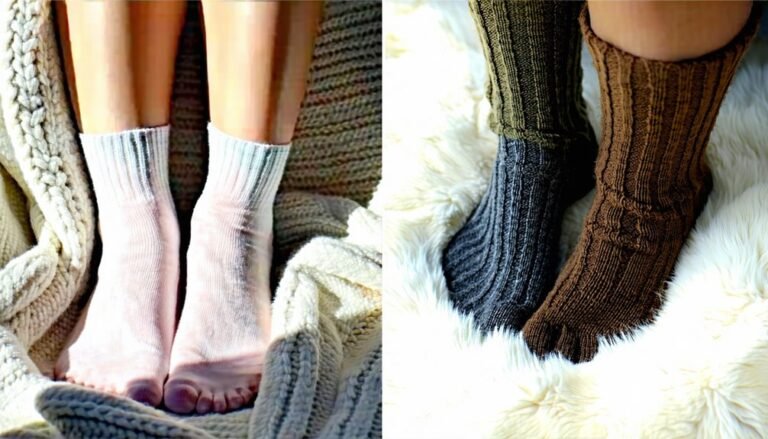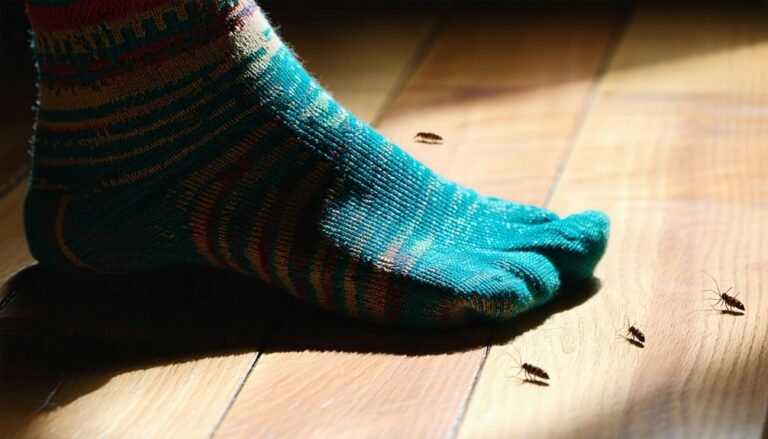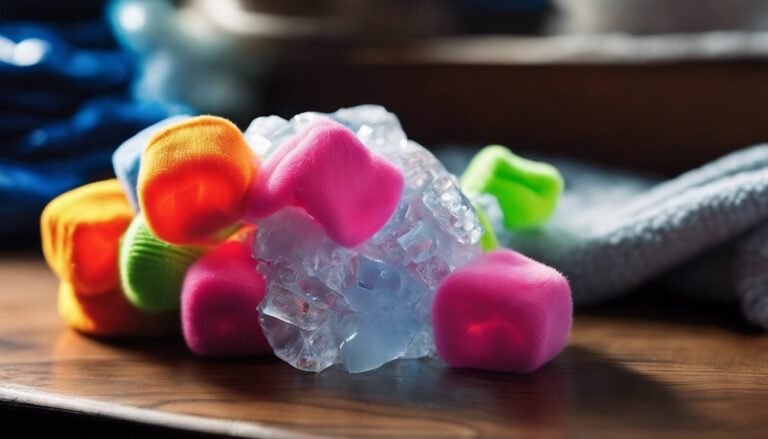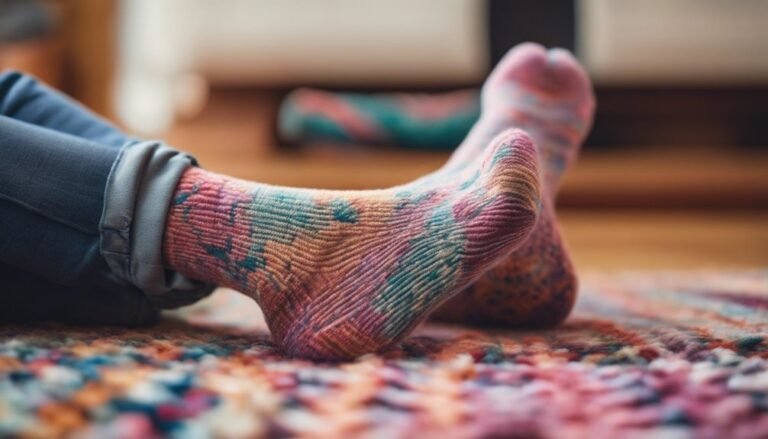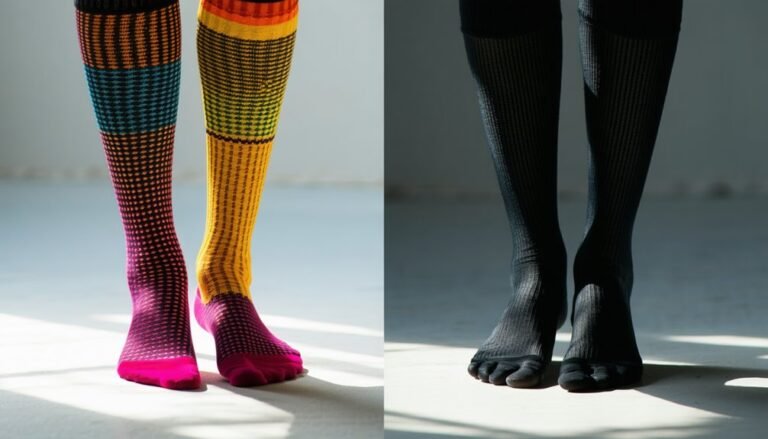How to Spot High-Quality Socks: Key Features to Look For
To spot high-quality socks, focus on material composition, cushioning, and moisture-wicking properties. Look for high-quality fibers like merino wool and synthetic blends for durability and comfort. Check for effective cushioning that supports your arch while managing moisture. Examine seams; flat seams reduce irritation and enhance fit. Guarantee the socks wick moisture effectively and provide breathability. Evaluate durability in high-wear areas. These features combined can greatly enhance your overall sock experience, and there's much more to explore.
Material Composition: Understanding Fabrics

When it comes to high-quality socks, material composition plays an essential role in performance and comfort. Different fabric types greatly impact how socks perform during various activities. For example, merino wool offers excellent moisture-wicking properties and temperature regulation, making it ideal for outdoor enthusiasts. Synthetic blends, such as nylon and polyester, enhance durability and elasticity, allowing for a snug fit without compromising movement. Additionally, cotton provides breathability but may retain moisture, which can lead to discomfort. Understanding the performance characteristics of these fabrics helps you choose socks that align with your lifestyle. Whether you value breathability, insulation, or stretch, selecting the right material is key to ensuring your socks support your freedom of movement and overall experience.
Cushioning and Padding: Enhancing Comfort
Cushioning and padding in socks greatly impact your overall foot comfort during wear. You'll want to contemplate the materials used, as certain options provide superior shock absorption and support. Analyzing these features can help you choose socks that enhance your comfort and performance.
Impact on Foot Comfort
How can the right cushioning and padding transform your sock experience? Quality cushioning greatly enhances foot comfort, reducing foot fatigue and promoting proper arch alignment. Here are four key benefits of well-designed cushioning:
- Shock Absorption: Cushioned socks minimize impact, protecting your feet during high-impact activities.
- Pressure Distribution: Padding evenly distributes pressure across your foot, reducing hotspots and discomfort.
- Arch Support: Effective cushioning provides targeted support for your arches, enhancing stability and reducing fatigue.
- Temperature Regulation: Quality materials in cushioning help manage moisture and temperature, keeping your feet dry and comfortable.
When you prioritize these features, you're investing in a sock experience that liberates your feet from discomfort, allowing you to focus on your activities without distraction.
Materials for Effective Cushioning
Choosing the right materials for cushioning can greatly enhance the comfort benefits discussed earlier. High-quality socks often utilize specific cushioning types and material blends to provide superior support. Look for socks made with:
| Material | Benefits | Ideal Use |
|---|---|---|
| Merino Wool | Moisture-wicking & soft | Everyday & outdoor |
| Polyester | Durable & lightweight | Sports & active wear |
| Nylon Blend | Stretch & shape retention | Fitting & supportive wear |
Each of these materials contributes to effective cushioning by reducing impact and increasing comfort. By understanding these elements, you can choose socks that not only feel good but also enhance your freedom to move throughout the day.
Seam Construction: The Importance of Flat Seams
Although often overlooked, seam construction plays an essential role in the overall comfort and durability of socks, particularly when it comes to flat seams. Flat seams minimize bulk and friction, enhancing your wearing experience. Here are four key benefits of flat seams:
- Comfort: They reduce pressure points, preventing irritation during extended wear.
- Durability: Flat seams are typically more robust than other seam types, enhancing seam durability over time.
- Fit: They provide a streamlined fit, allowing for better movement and flexibility.
- Breathability: Flat seams contribute to improved airflow, helping maintain a comfortable temperature.
Investing in socks with quality seam construction guarantees you enjoy both freedom and performance in your daily activities.
Moisture-Wicking Properties: Keeping Feet Dry
When evaluating moisture-wicking properties, the type of fabric used in your socks is essential; synthetic fibers like polyester and nylon often outperform natural fibers in moisture management. Additionally, breathability and ventilation features play a pivotal role in ensuring that sweat evaporates efficiently, keeping your feet dry and comfortable. Understanding these elements will help you choose socks that effectively combat moisture.
Fabric Types Matter
Fabric types play an essential role in the performance of high-quality socks, particularly in their moisture-wicking properties. When choosing socks, consider these four fabric types:
- Merino Wool – Naturally moisture-wicking, it regulates temperature and resists odor.
- Polyester – Quick-drying and durable, it effectively draws moisture away from your skin.
- Nylon – Adds strength and elasticity, enhancing comfort while maintaining moisture control.
- Bamboo – Sustainable and soft, it offers excellent moisture-wicking along with natural antibacterial properties.
Breathability and Ventilation
How can you guarantee your socks keep your feet dry and comfortable during any activity? Look for socks engineered with moisture-wicking properties that actively draw sweat away from your skin. High-quality materials like merino wool or advanced synthetic fibers enhance breathability and ventilation, ensuring ideal heat regulation. These fabrics not only manage moisture but also allow for airflow, preventing the buildup of heat and humidity. When selecting socks, check for mesh panels or strategic venting, which further boost breathability. By prioritizing moisture management, you'll maintain a dry, comfortable environment for your feet, whether you're running, hiking, or simply enjoying a casual day out. The right sock can liberate you from discomfort, allowing you to focus on what truly matters: your freedom to move.
Breathability: Ensuring Airflow
While you might focus on style or cushioning when choosing socks, breathability plays an essential role in ensuring comfort and foot health. Proper air circulation allows your feet to stay dry and cool, which is vital for temperature regulation. Here are key features to look for:
- Moisture-wicking fabrics: They draw sweat away, preventing dampness.
- Mesh zones: Strategically placed areas enhance airflow.
- Natural fibers: Materials like merino wool provide breathability and odor resistance.
- Compression technology: This can improve circulation while still allowing for ventilation.
Fit and Sizing: Finding the Right Match

When selecting socks, achieving the right fit and size is essential, as an improper match can lead to discomfort, blisters, and reduced performance. To guarantee ideal fit, refer to sizing charts that correlate with your specific foot measurements.
| Size Category | Foot Measurement (inches) |
|---|---|
| Small | 8 – 9 |
| Medium | 9.5 – 10.5 |
| Large | 11 – 12 |
Measuring your foot accurately is key, so use a ruler or measuring tape for precision. Consider the sock's intended use—athletic, casual, or dress—as this can influence sizing preferences. A well-fitting sock provides freedom of movement, enhancing your overall comfort and experience. Choose wisely!
Durability: Evaluating Longevity
When evaluating the durability of socks, you'll want to prioritize material quality and its impact on longevity. High-quality fibers resist wear and tear, while the stitching and overall construction determine how well the socks can maintain their shape and integrity over time. Evaluating these factors will help you identify socks that stand up to regular use without significant deterioration.
Material Quality Importance
Material quality plays a pivotal role in determining the durability of socks, influencing their longevity and overall performance. When evaluating fabric types, you'll want to reflect on several key factors that impact sock longevity:
- Material Composition: Look for blends that include high-quality fibers like merino wool, which offers resilience and moisture-wicking properties.
- Weight: Heavier fabrics typically withstand wear and tear better than lighter options.
- Breathability: Fabrics that allow air circulation help prevent deterioration caused by moisture accumulation.
- Elasticity: High-elasticity materials maintain shape and fit over time, reducing the risk of sagging or bunching.
Stitching and Construction Quality
Although you might focus on fabric type, the stitching and overall construction quality of socks are equally essential for ensuring durability. Look for advanced stitching techniques, like flatlock seams, which reduce bulk and prevent chafing. A sock's longevity often hinges on its reinforcement areas, particularly at the heel and toe, where wear is most pronounced. High-quality socks utilize additional fibers or thicker yarns in these zones, enhancing durability. Furthermore, examine the density of stitches; a tighter stitch often indicates better resilience against fraying and unraveling. Evaluating these factors can greatly influence your sock experience, ensuring you enjoy both comfort and freedom without the constant need for replacements. Prioritize craftsmanship to achieve lasting wear and performance.
Arch Support: Enhancing Stability
Effective arch support is essential for enhancing stability in high-quality socks, especially for those who spend long hours on their feet. The right arch support can greatly impact comfort and performance. Here are some key arch support benefits and types to take into account:
- Shock Absorption: Reduces impact on joints, promoting overall foot health.
- Alignment: Helps maintain proper foot alignment, decreasing the risk of injury.
- Comfort: Provides a cushioned feel, reducing fatigue during prolonged wear.
- Versatility: Available in various styles, including built-in support or removable inserts.
Understanding these arch support types will empower you to make informed choices, ensuring your socks not only enhance performance but also contribute to your long-term foot health.
Compression: Benefits for Performance and Recovery
When you're looking to enhance your athletic performance and aid recovery, the role of compression in socks can't be overlooked. Compression therapy applies graduated pressure to your legs, promoting better blood circulation and reducing muscle vibration during physical activity. This results in improved oxygen delivery to your muscles, which is vital for performance enhancement. Additionally, wearing compression socks post-exercise helps minimize swelling and muscle soreness, expediting recovery time. By choosing high-quality compression socks, you'll experience increased stability and support, allowing you to push your limits without the fear of injury. Fundamentally, integrating compression technology into your sock selection can greatly impact your overall athletic experience, providing you with the freedom to perform at your best.
Style and Design: Balancing Functionality With Aesthetics

After considering the performance benefits offered by compression socks, it's important to acknowledge that style and design also play significant roles in your sock selection. The right sock not only enhances your wardrobe but also complements your lifestyle. Here are key aspects to evaluate:
- Fashion Trends: Stay updated on current styles to guarantee your socks are fashionable.
- Color Coordination: Choose colors that harmonize with your outfits for a polished look.
- Pattern Variety: Look for unique patterns that express your personality without compromising functionality.
- Material Choice: Select breathable, moisture-wicking fabrics that maintain their aesthetic appeal.
Balancing these elements will give you socks that are both functional and visually appealing, allowing you to feel free and confident in any setting.
Frequently Asked Questions
How Often Should I Replace My Socks for Optimal Performance?
To guarantee ideal performance, you should replace your socks every six months, considering sock lifespan and materials. High-quality fibers resist wear better, so investing in durable options can extend their usability considerably.
Can Socks Cause Foot Odor, and How Can I Prevent It?
Yes, socks can cause foot odor due to moisture retention. To prevent this, choose breathable sock materials like merino wool or moisture-wicking synthetics, which enhance odor prevention and keep your feet fresh and comfortable.
Are There Specific Socks for Different Types of Footwear?
Yes, there are specific socks designed for different footwear. Look for materials like merino wool or synthetic blends that enhance breathability and moisture-wicking properties, ensuring footwear compatibility while providing comfort and performance tailored to your needs.
How Do I Properly Wash and Care for My Socks?
While delicate fabrics demand gentle handling, durable materials withstand harsher methods. When washing your socks, use appropriate techniques like cold water and air drying to preserve elasticity and prevent wear, ensuring they last longer for your adventures.
What Are the Best Socks for Specific Sports or Activities?
When choosing socks for specific activities, consider running socks designed for moisture-wicking and cushioning. For hiking, opt for durable, padded hiking socks that offer arch support and thermal regulation, ensuring comfort and performance during your adventures.


